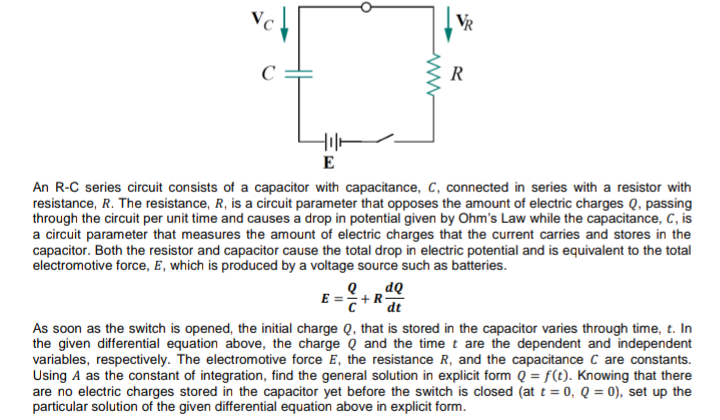An R-C series circuit consists of a capacitor with capacitance, C, connected in series with a resistor with resistance, R. The resistance, R, is a circuit parameter that opposes the amount of electric charges Q, passing through the circuit per unit time and causes a drop in potential given by Ohm's Law while the capacitance, C, is a circuit parameter that measures the amount of electric charges that the current carries and stores in the capacitor. Both the resistor and capacitor cause the total drop in electric potential and is equivalent to the total electromotive force, E, which is produced by a voltage source such as batteries. E =+R dt As soon as the switch is opened, the initial charge Q, that is stored in the capacitor varies through time, t. In the given differential equation above, the charge Q and the time t are the dependent and independent variables, respectively. The electromotive force E, the resistance R, and the capacitance C are constants. Using A as the constant of integration, find the general solution in explicit form Q = f(t). Knowing that there are no electric charges stored in the capacitor yet before the switch is closed (at t = 0, Q = 0), set up the particular solution of the given differential equation above in explicit form.
An R-C series circuit consists of a capacitor with capacitance, C, connected in series with a resistor with resistance, R. The resistance, R, is a circuit parameter that opposes the amount of electric charges Q, passing through the circuit per unit time and causes a drop in potential given by Ohm's Law while the capacitance, C, is a circuit parameter that measures the amount of electric charges that the current carries and stores in the capacitor. Both the resistor and capacitor cause the total drop in electric potential and is equivalent to the total electromotive force, E, which is produced by a voltage source such as batteries. E =+R dt As soon as the switch is opened, the initial charge Q, that is stored in the capacitor varies through time, t. In the given differential equation above, the charge Q and the time t are the dependent and independent variables, respectively. The electromotive force E, the resistance R, and the capacitance C are constants. Using A as the constant of integration, find the general solution in explicit form Q = f(t). Knowing that there are no electric charges stored in the capacitor yet before the switch is closed (at t = 0, Q = 0), set up the particular solution of the given differential equation above in explicit form.
Introductory Circuit Analysis (13th Edition)
13th Edition
ISBN:9780133923605
Author:Robert L. Boylestad
Publisher:Robert L. Boylestad
Chapter1: Introduction
Section: Chapter Questions
Problem 1P: Visit your local library (at school or home) and describe the extent to which it provides literature...
Related questions
Question

Transcribed Image Text:VR
C
R
E
An R-C series circuit consists of a capacitor with capacitance, C, connected in series with a resistor with
resistance, R. The resistance, R, is a circuit parameter that opposes the amount of electric charges Q, passing
through the circuit per unit time and causes a drop in potential given by Ohm's Law while the capacitance, C, is
a circuit parameter that measures the amount of electric charges that the current carries and stores in the
capacitor. Both the resistor and capacitor cause the total drop in electric potential and is equivalent to the total
electromotive force, E, which is produced by a voltage source such as batteries.
E=+Rat
As soon as the switch is opened, the initial charge Q, that is stored in the capacitor varies through time, t. In
the given differential equation above, the charge Q and the time t are the dependent and independent
variables, respectively. The electromotive force E, the resistance R, and the capacitance C are constants.
Using A as the constant of integration, find the general solution in explicit form Q = f(t). Knowing that there
are no electric charges stored in the capacitor yet before the switch is closed (at t = 0, Q = 0), set up the
particular solution of the given differential equation above in explicit form.
Expert Solution
This question has been solved!
Explore an expertly crafted, step-by-step solution for a thorough understanding of key concepts.
Step by step
Solved in 2 steps

Knowledge Booster
Learn more about
Need a deep-dive on the concept behind this application? Look no further. Learn more about this topic, electrical-engineering and related others by exploring similar questions and additional content below.Recommended textbooks for you

Introductory Circuit Analysis (13th Edition)
Electrical Engineering
ISBN:
9780133923605
Author:
Robert L. Boylestad
Publisher:
PEARSON

Delmar's Standard Textbook Of Electricity
Electrical Engineering
ISBN:
9781337900348
Author:
Stephen L. Herman
Publisher:
Cengage Learning

Programmable Logic Controllers
Electrical Engineering
ISBN:
9780073373843
Author:
Frank D. Petruzella
Publisher:
McGraw-Hill Education

Introductory Circuit Analysis (13th Edition)
Electrical Engineering
ISBN:
9780133923605
Author:
Robert L. Boylestad
Publisher:
PEARSON

Delmar's Standard Textbook Of Electricity
Electrical Engineering
ISBN:
9781337900348
Author:
Stephen L. Herman
Publisher:
Cengage Learning

Programmable Logic Controllers
Electrical Engineering
ISBN:
9780073373843
Author:
Frank D. Petruzella
Publisher:
McGraw-Hill Education

Fundamentals of Electric Circuits
Electrical Engineering
ISBN:
9780078028229
Author:
Charles K Alexander, Matthew Sadiku
Publisher:
McGraw-Hill Education

Electric Circuits. (11th Edition)
Electrical Engineering
ISBN:
9780134746968
Author:
James W. Nilsson, Susan Riedel
Publisher:
PEARSON

Engineering Electromagnetics
Electrical Engineering
ISBN:
9780078028151
Author:
Hayt, William H. (william Hart), Jr, BUCK, John A.
Publisher:
Mcgraw-hill Education,